SLOW ASTERN
Δημοσιεύθηκε: 26 Οκτωβρίου, 2008 Filed under: aegean, Greece, Ikaria, Ικαρία, ικαρία, lifestyle, scouting, Travel, Uncategorized | Tags: Aegean, art, artful, gardens, Greece, heritage, Ikaria, ikaria-1974-5, παράδοση, ιστορία, ικαρία, landscapes, lifestyle, old things, olive oil, ovens, reservoirs, simple life, stonewalls, tools, tradition, traditional, vegetables, village, wheat, why-ikaria, wine 11 Σχόλια Hello!
Hello!In case some readers thought that all I love about my favorite island is nature, I hope this post will make them change their minds. Because, connected with that nature, inside that nature, befriended with that nature, a very peculiar civilization developed and lived for centuries until the introduction of fossil fueled engines, motor roads, electricity, market economy and finally, tourism.
 Speaking about Ikaria, due to its isolation and geomorphology always some steps back in development, this civilization which presumably dated from the Age of Stone, ended as incredibly late as the 1960s.
Speaking about Ikaria, due to its isolation and geomorphology always some steps back in development, this civilization which presumably dated from the Age of Stone, ended as incredibly late as the 1960s. 
Jeff Soan a wood carver and toy maker from England, whose work is often inspired from traditional arts and crafts from around the world, visited the island in 1974, just in time to catch the last gleam of the old Ikarian culture.
The right man in the right time, Jeff Soan drew and described what he saw in his tiny sketchbook and several decades later he published all that in his webpage.
How lucky was I to discover it!
The original site has dropped off but somehow, I managed to save a few paragraphs. The sketchbook page scans, however, are still on!
Here they are, 30 of them, all together. As I took the liberty to load everything on my blog, if you click on the thumbnails, you will be able to see the sketchbook pages in large size. Under each page I have added captions containing typed transcriptions of Jeff’s amazing handwritten notes – admirable evidence of his deep understanding of the artifacts and objects described as well as of his respect for the age-old civilization  to which they belonged.
to which they belonged.
I share the same feelings with him.
You see, I don’t only love nature in Ikaria!
But let Jeff speak now:
«Ikaria is a Greek island situated in the North Eastern Agean group, close to Samos and the Turkish mainland. I drew and took notes on the things I saw there».
«In 1973 Barbara and I met, fell in love, and decided to leave England early in the spring of 1974 in order to travel to Greece. The intention was to spend a year living Greek life. I had visited mainland Greece, a place called Narantziza, a few years previously and was desperate to return to pick oranges and lemons in the autumn, it seemed such an exotic thing to do. A friend had told me of a windy island in the North Eastern Agean group that he had visited and after a few weeks acclimatising and pulling urchin needles out of our feet we undertook the 12 hour ferry sailing out to Ikaria.»
The Olive
(elliess)
«The Olive Tree lives to a great age becoming gnarled and twisted during growth. Olives are borne on the wood of the previous year’s growth. Every part of the tree is used – the olives themselves for oil and eating, the leaves are fed to animals, the wood for bowls and utensils. The wild shoots can be used in making woven baskets – and whatever is left over for the fire in the cold winter months.
The olive tree spreads its roots far into the rocky soil and prevents land erosion. Terraces formed on sloping ground for an olive grove hundreds of years ago remain as terraces, the roots preventing natural land slip.»
«Olive trees require little or no attention during the year. Occasional pruning prevents them from going wild – the wild shoots obtained are extremely supple – perfect for basketwork. The olives ripen from November until January and are picked from the ground and lower branches. The fruit higher up in the tree is either left until it eventually falls, or is knocked off with a long stick and collected with a sheet underneath. Branches crack easily so they aren’t climbed.»
Large foorno with chimney
«A large oven is constructed from bricks, broken pithari, tiles and red clay to stick it all together. It often extends from the side of the house. The oven is made by first placing sticks covered by ferns and then earth on top to form a flat hemispherical shape. Broken pots and bricks are then cemented with red clay over the top of this dome. An access arch is formed in the wall of the house and a chimney above the door. The dome is insulated further with red clay and pot fragments and filled in with earth. A roof is constructed over it to protect from the rain. The interior floor is of red clay. Six or seven hours firing is required to harden the clay. When the correct temperature is reached glass bottles will melt inside and these can be used to give a smooth bottom. Six to twelve loaves may be baked at a time depending on the size.»
Storage pots (pithari)
and ‘Pithari’ foorno
«Formed from red clay. The various sizes but usually large, used for storing wine and olives. Often buried in the ground or built into a terrace, and surrounded with earth and stones. The lid is often a circular slate with a hole cut in it to take a brushwood handle. Often found in groups near the wine press. Any decoration near the top is simple as they were made not to stand to be built in and covered. They can be used to make ‘beehive’ shaped oven.
A pithari oven is constructed by laying a pithari on its side and packing round with broken pots, tiles and red clay. It is covered with earth and stones as insulation and made weatherproof. The inside is first filled with sand to a level coinciding with the lip, then red clay is packed on top to a height that gives maximum use of floor space and height (usually just below centre). The clay is left to harden and then fired to a high temperature using brushwood. Ground glass can then be sprinkled to give a smooth bottom. After firing the ashes are pulled to the front and a stone placed over the door of the oven. In addition a lower door may be let in to apply extra heat during cooking.»
Tools for bread making:
«1) Bracken bunched and tied to the end of the stick to brush small bits of charcoal (pana or panisma).
2) Wooden spade for manoeuvring dough and bread (psomophtiaro).
3) Scraper are for pulling ashes to the front of the oven.
4) Bread mould carved from half log.».
PSOMΊ
(bread)
«The bread made by the majority of the islanders is a sour dough, that is dough which has been left to absorb wild yeasts. A portion of each week’s dough is kept back for future use, stored in a suitable container to prevent too much drying (a half coconut shell is excellent for this) on the night before baking and the dough is mixed with a little water at blood at temperature and covered with sifted flour. A mark is usually made in the surface of the flour (often a cross). It is covered with a cloth and left overnight in a warm place. In the morning the yeast / flour mix will have risen. It is made into a soft dough by adding water and kneading well. The required amount of sifted flour is added. By dipping the hands into a bowl of warm water and constantly on kneading the mix for at least an hour, the yeast is distributed throughout the mix and air introduced. The dough is then formed into flattened spheres and a handful of dough kept back for future use. The dough is covered with flour and placed into cloth lined baskets.
This is then covered with blankets and kept in a warm place for four hours or until the dough has risen. The furnace is prepared by burning brushwood (anima is best for this) for at least half an hour. The inside of the furnace turns a sandy white when the correct temperature is reached. The ashes are pulled to the front and the interior brushed clean. A suitable flat stone is placed on the ashes inside to prevent hot charcoal falling on to the bread when the door is closed. The dough is then flopped on to the psomophtiaro so that its bottom in the basket becomes the top of the loaf. They are then slid into the furnace and left to cook. When the top surface is brown the loaves are stacked to the sides of the furnace to cook on the bottom a little. After removing the loaves the oven is at a temperature suitable for cooking meals, pastries, etc.»
Rusks
(paximathi)
«Unused and stale bread is cut into thin strips soaked a little and baked for many hours as the oven cools. They may be stored indefinitely as they do not mould. They are too hard to be eaten directly but are dunked in soup, goat’s milk, or tea.».
ALLONI
(Threshing floor)
«Large, circular, stone floor with upright slates around the perimeter. Usually situated at the base of a number of terraces where wheat is grown. The whole wheat is spread evenly around the perimeter and a mule, donkey, horse of even cows is made to walk around, for a number of hours, while a man leads and coaxes from the center. The wheat is turned occasionally during the process. Threshing a grain crop can be completed in a day by the above process. Although very little wheat is now grown on the island, in those days very large crops were produced; the extraordinary number of ‘pezoulia’ (terraces) bear witness to this.
Manual labour was reduced by introducing a brake at the center with a tube-like top into which a wooden arm could be fitted and the animal controlled in this way.»
Water conservation reservoirs
«Most rivers will dry up completely during the summer months. What little water is left in larger rivers tends to disappear underground or meander so much over the riverbed that it is absorbed. The method above of damning and reserving water is the most common on the island. Walls are built at a suitable site on the riverbed and a watertight finish obtained by placing a large flat stones up right against the wall on the waterside. The joins are sealed with clay and grass or cement. The drain and plug are simply a large stone let in to an opening with whole board into it, in which fits a branch. The rate of flow is controlled by using different sized branches. To seal completely the largest sized branch is used and packed around with leaves and mud The reservoir is situated above a number of gardens which it serves. Water is allowed constantly to seep out to the next reservoir situated further down the river valley. When required, water is directed into irrigation channels on either side of the valley.»
Gardens
(gkipos)
«Very little land in the valleys is flat of course and so workable areas are formed by stepping on the land into terraces (bezoulia) earth is piled up around small areas to form trenches with removable openings for of grass and flat stones. Each trench is filled with water by opening the door and stopping the flow to the next trench. When filled to the brim the door is closed and the same procedure adopted for the following a trench. When all the trenches on one level are filled the water is allowed to flow to a lower terrace. Fertiliser can be placed in the openings where the water flow will carry and eventually distribute it among the plants. The amount of water applied in this way in one session is sufficient to meet the plants needs for one week. The more usual plants grown in this way are string beans, sweet corn, peppers, aubergines, tomatoes, courgette, cucumber and a number of salad crops, vlita and horta.»
NEROMILOS
Watermill
«From the days when much wheat was grown on the island – a ‘neromilos’ was an alternative to the ‘anemomilos’ (windmill).
Motive power was obtained by water entering a 30 foot tower and being constricted at the bottom, thus emerging under pressure.
Water is stored in a large reservoir upstream and when released flows down an irrigation channel and into the top of the tower.
The diameter of the chimney at the top of the tower is 3 feet gradually decreasing in diameter, and finally curving until its horizontal and only 6 inches in diameter. The water emerges under considerable pressure onto one side of the paddle wheel effecting the required circular motion…».
«The main body of water exits at the front of the mill house and the remainder eddies and emerges at the side. The shaft of the paddle wheel is directly connected to the upper mill-stone. The paddles themselves numbering about 25 are hollowed out from a small log. They are called ‘koutalli’ (spoons).»
.
«In the millhouse itself is the above arrangement. Grain is fed to the hopper situated above the millstones – the amount entering the hole in the top stone controlled by an adjustable feeder.
Ground flow exits through a hole in the lower stone and into the flour trough. The brakeprobably deflected the flow of water away from the paddles.
With the decline of the population and thus the decline of home grown wheat the mill lost business and finally ceased to operate in 1953.».
KAMINI
Lime kiln
«In the wilder, more exposed parts of the island huge quantities of ‘marmaron’ – marble is to be found which was used for the production of ‘asvesti’ – lime and whitewash. At a suitable site (an area where there was plenty of wood available) one of the above structures would be built from large rocks incorporating a narrow ledge around the base, inside. On this ledge small pieces of marble would be laid at an angle all around. On the next layer, slightly larger pieces are laid at the opposite angle herring bone fashion (‘psarococalo’).
Continuing in this way a dome structure is built up on the inside and this forms the lining of the kiln. The kiln is continuously fired for 36-48 hours – the inside temperature reaching 3000°C.»
MILOS – Domestic mill
HERΌMILOS – Hand-mill
«Found in most, if not all, older houses. Made of hard, composite rock. The lower slab set permanently into a stand diagonally across a corner of the room at a suitable working height. Wheat grain is poured with the left hand into the central hole and the top slab swung around the central pivot in an anti-clockwise direction by the loose-fitting wooden handle.
The upper stone is grooved on its underside in shallow spiral rays to facilitate a constant flow of flour all around the mill. A leather washer also helped in maneuvering the rather heavy top slab.
There being no suitable stone on the island for grinding, all millstones were imported, usually from Turkey – most coming from an area now known as ‘MILOS’.
An alternative groove design – herring bone (‘psarococalo’) found on a large, heavier hand mill.»
HASTRI
Clay pot beehive
«Α simple […?] of clay which functions as a beehive and encloses all the popular wisdom and the Ikarian tradition. That is ‘Hastri’. It first appeared hundreds of years ago in the Ikarian laboratories of clay. Contemporary methods have managed to substitute it completely. Many people of the island still use it with an ardent wish and faith in tradition.
Thus ‘Hastri’, symbol of a unique era, constitutes the most vivid proof of the Ikarian experience in honey which offers a discreet taste in our life.»
KRASHI
(Wine)
«…The must is then transferred to large ‘pitharis’ under shelter. These have stone lids with brushwood handles to allow air to escape. The fermenting (the Greeks say ‘boiling’) must is left from 4-8 weeks before being transferred to more convenient containers.
Gourds used as, left – dipper, and right – with bamboo additions as siphon.
Fresh grape juice, boiled with ashes from the fire and flour added makes a delicious jelly sweet called ‘mustalevria’. Instead of ashes a slice of bread is sometimes put in to cut some of the sweetness.
Many varieties and qualities of wine are produced which fall into three categories: 1) ‘Mavro’ (black) which is a deep red, rich wine, 2) A rosé type lighter wine, 3) Retzina which is wine preserved by the addition of resin.
In addition, water-wine is made which is ready to drink two weeks after treating.
The wine is at its best at Christmas time.»
ANEMOMILOS
(Windmill)
«A familiar sight on many hilltops of the island – the ruins of an anemomilos – windmill. The useful machinery inside was taken out of all of them after they ceased to operate. All, being in exposed positions, soon deteriorated in the strong winds. Ikaria’s former name (one of many) was ‘Anemoessa’ (windy).
Plastered and whitewashed with thatched roofs and with numerous triangular sails – they must have been a fine sight in earlier days. The remaining clues inside are few. A spiral staircase inside gave access to the spindle/axe and gear mechanism. Holes in the surrounding wall at knee-level probably supported the mill stones.»
.
Tuesday, October 26, 2008
Next post:
«Ikaria in Images (3)»
Previous post:
«Back int(r)o MyWorld»
Comments
(1 total)
Interesting! I suppose this for you is called
«Everyday life on a Greek island in Late Neolithic»
🙂
Tuesday October 26, 2008 – 06:10am (PST)
Wheat, oil, wine, vegetables, water. Yes, and occasionally some baked meat in the oven:-)
Thursday October 28, 2008 – 09:57pm (EET)
.


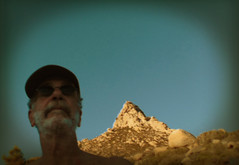






















![Jeff Soan’s Ikaria 1974 – hastri: A simple [..?] of clay which functions as a beehive and encloses all the popular wisdom and the Ikarian tradition. That is ‘Hastri’. It first...](https://egotoagrimi.files.wordpress.com/2018/02/jeff-soans-ikaria-1974-hastri.jpg?w=107&h=144)





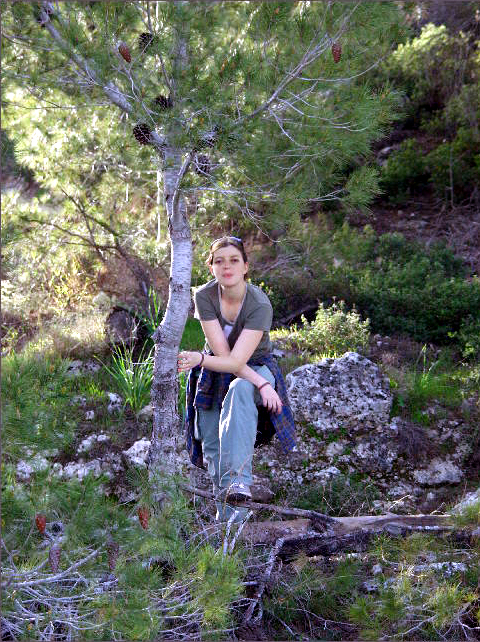
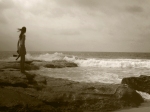


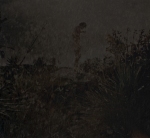


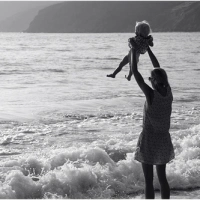



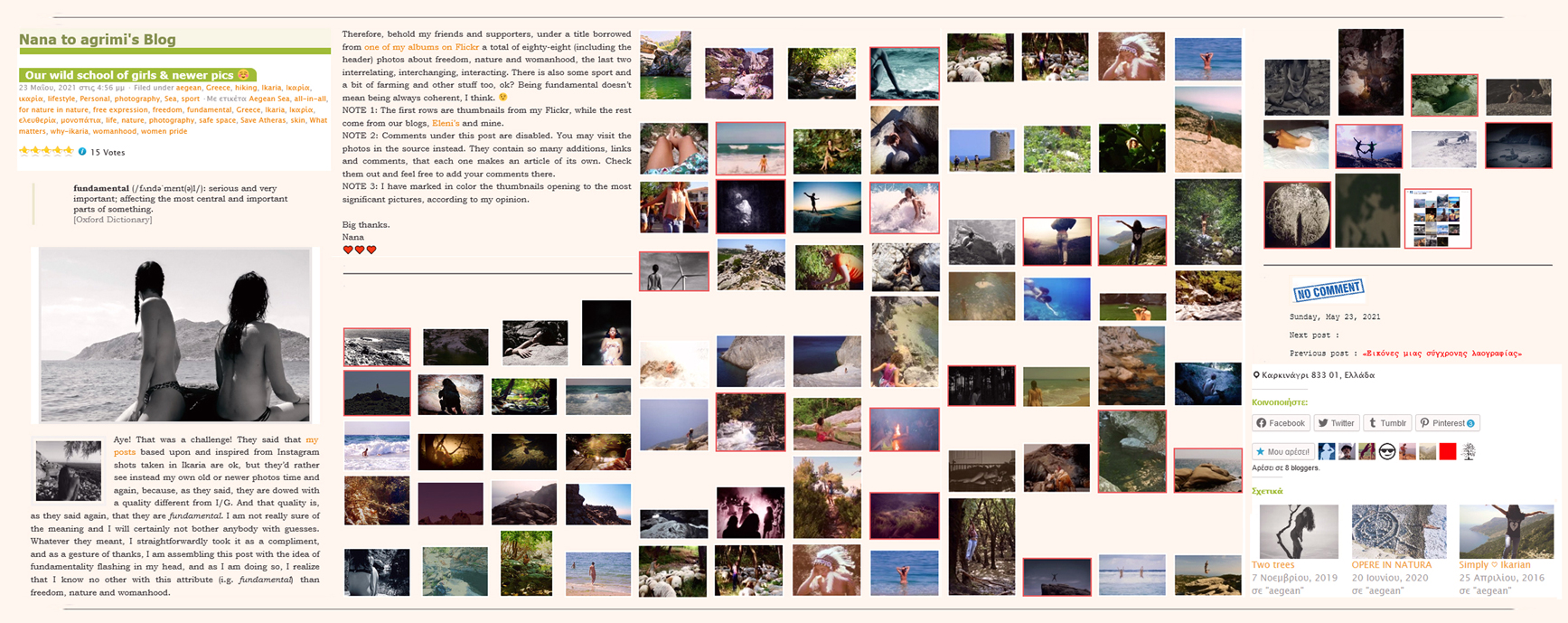




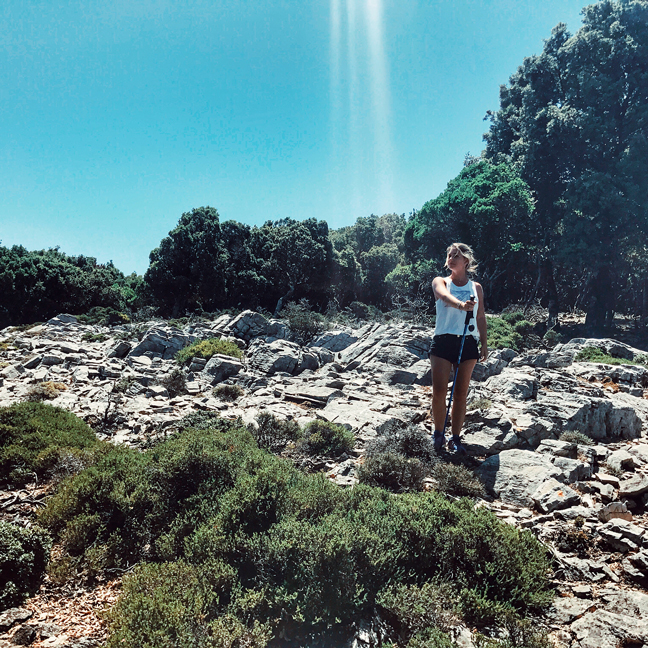
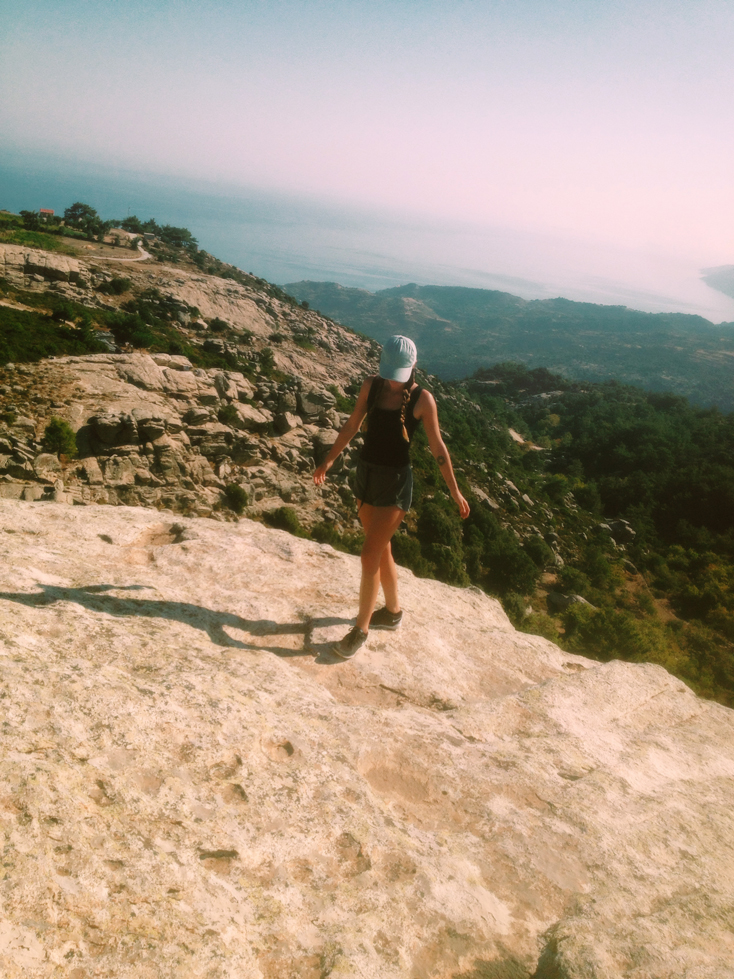


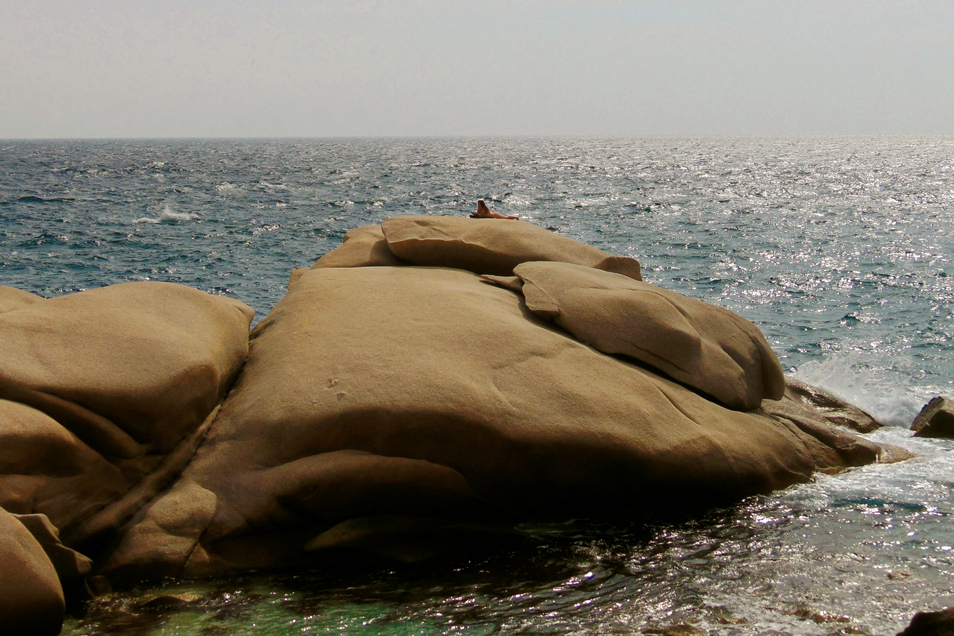

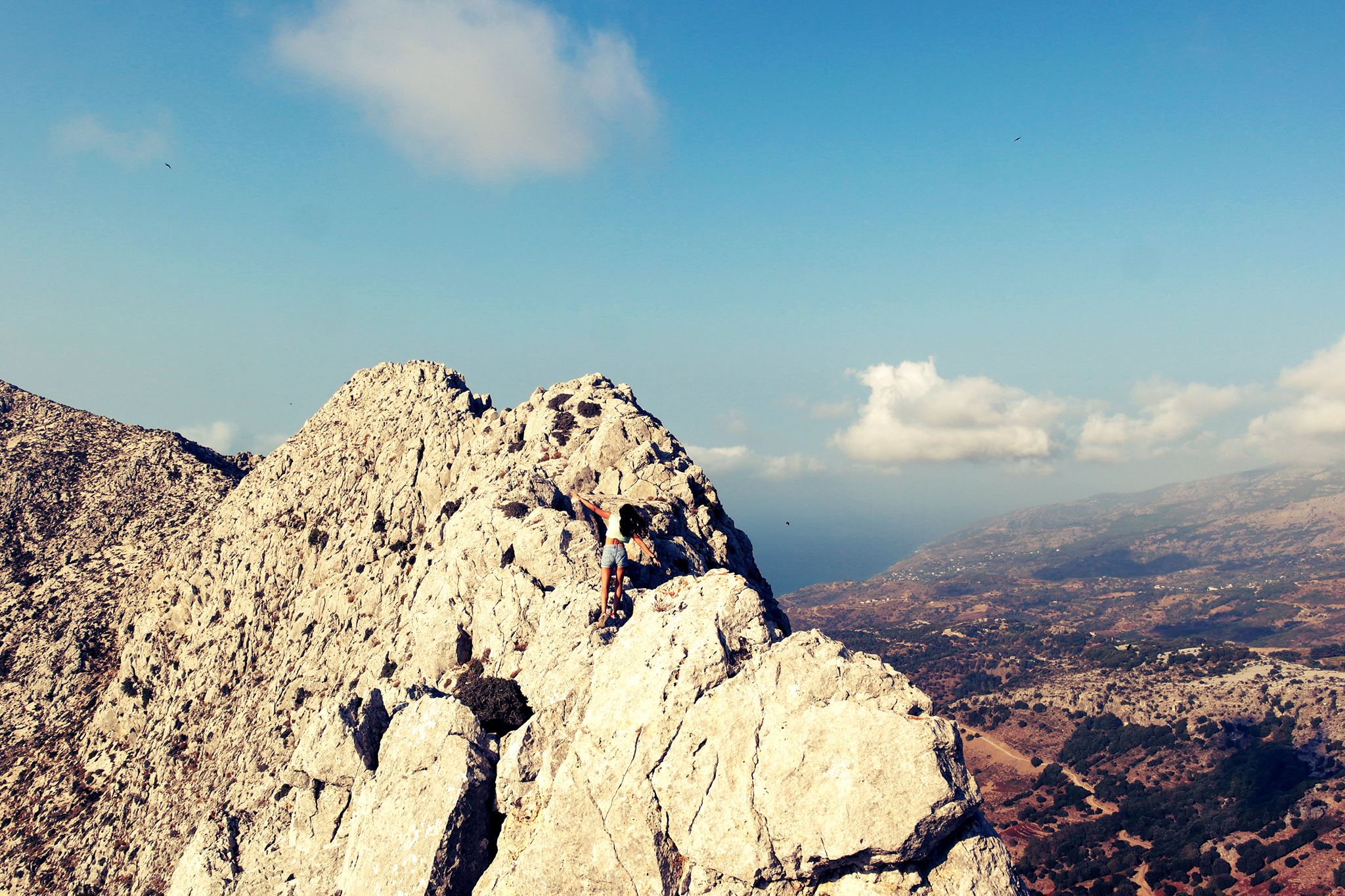











Our backs tell stories no books have the spine to carry - rupi kaur https://www.instagram.com/p/C0RdZ-PNet_/?taken-by=schwickertt/